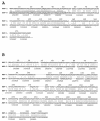Genome of bovine herpesvirus 5
- PMID: 12970418
- PMCID: PMC228503
- DOI: 10.1128/jvi.77.19.10339-10347.2003
Genome of bovine herpesvirus 5
Abstract
Here we present the complete genomic sequence of bovine herpesvirus 5 (BHV-5), an alphaherpesvirus responsible for fatal meningoencephalitis in cattle. The 138390-bp genome encodes 70 putative proteins and resembles the alpha2 subgroup of herpesviruses in genomic organization and gene content. BHV-5 is very similar to BHV-1, the etiological agent of infectious bovine rhinotracheitis, as reflected by the high level of amino acid identity in their protein repertoires (average, 82%). The highest similarity to BHV-1 products (>or=95% amino acid identity) is found in proteins involved in viral DNA replication and processing (UL5, UL15, UL29, and UL39) and in virion proteins (UL14, UL19, UL48, and US6). Among the least conserved (<or=75%) are the homologues of immediate-early (IE) proteins BICP0, BICP4, and BICP22, the three proteins being longer in BHV-5 than in BHV-1. The structure of the BHV-5 latency-related (LR) region departs markedly from that of BHV-1 in both coding and transcriptional regulatory regions. Given the potential significance of IE genes and the LR region in virus-neuron interactions, it is likely these differences contribute to BHV-5 neuropathogenicity.
Figures



References
-
- Abdelmagid, O. Y., H. C. Minocha, J. K. Collins, and S. I. Chowdhury. 1995. Fine mapping of bovine herpesvirus-1 (BHV-1) glycoprotein D (gD) neutralizing epitopes by type-specific monoclonal antibodies and sequence comparison with BHV-5 gD. Virology 206:242-253. - PubMed
-
- Altschul, S. F., W. Gish, W. Miller, E. W. Myers, and D. J. Lipman. 1990. Basic local alignment search tool. J. Mol. Biol. 215:403-410. - PubMed
-
- Ashbaugh, S. E., K. E. Thompson, E. B. Belknap, P. C. Schultheiss, S. Chowdhury, and J. K. Collins. 1997. Specific detection of shedding and latency of bovine herpesvirus 1 and 5 using a nested polymerase chain reaction. J. Vet. Diagn. Investig. 9:387-394. - PubMed
MeSH terms
LinkOut - more resources
Full Text Sources
Other Literature Sources

